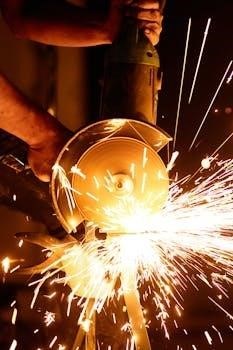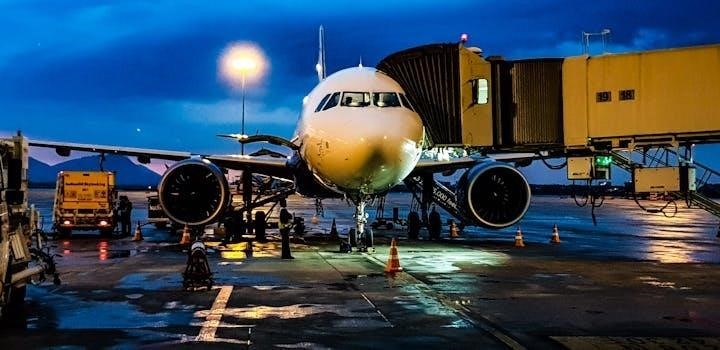Aircraft composites maintenance is crucial for ensuring the continued airworthiness of modern aircraft. This involves adhering to manufacturer guidelines and utilizing the aircraft structural repair manual (SRM) for proper repair procedures and documentation.
Importance of Composite Materials in Modern Aircraft
Composite materials are increasingly vital in modern aircraft due to their lightweight properties and high strength-to-weight ratio. This contributes to increased fuel efficiency and improved aircraft performance. Proper maintenance and repair of these composite structures are essential for maintaining the structural integrity and aerodynamic performance of the aircraft. Adhering to the aircraft’s structural repair manual and employing qualified technicians are crucial for ensuring safe and effective repairs of composite components.
Understanding Aircraft Structural Repair Manuals (SRM)
Aircraft Structural Repair Manuals (SRMs) are essential for guiding composite repair. They provide detailed instructions to return the structure to its original strength‚ stiffness‚ and aerodynamic requirements.
Role of SRM in Composite Repair Procedures
The Structural Repair Manual (SRM) is critical in composite repair‚ offering detailed‚ accurate instructions that technicians must follow. SRMs ensure repairs restore structural integrity and meet mass balance and aerodynamic requirements. These manuals incorporate established composite repair techniques and materials‚ often building upon successful methodologies from previous aircraft models. Following the SRM guarantees compliance with approved repair data and airworthiness standards for aircraft maintenance.
Common Types of Composite Damage
Composite materials in aircraft are susceptible to specific damages. Common issues include delamination‚ disbonds‚ and impact damage. Understanding these damage types is crucial for effective repair strategies.
Delamination and Disbonds
Delamination is a common issue in composite structures‚ characterized by the separation of laminate layers. Disbonds‚ on the other hand‚ involve the separation of bonded joints or interfaces. These types of damage can significantly reduce the structural integrity of aircraft components. Effective detection and repair methods‚ as outlined in the aircraft structural repair manual (SRM)‚ are crucial for maintaining safety. Regular inspections and adherence to proper repair procedures are essential in addressing delamination and disbond issues in aircraft composites.
Impact Damage
Impact damage in composite materials is a significant concern due to its potential for causing internal damage that is not readily visible. This type of damage can range from minor surface dents to severe matrix cracking and fiber breakage. Proper assessment using non-destructive testing (NDT) methods is essential to determine the extent of the damage. The aircraft structural repair manual (SRM) provides guidelines for evaluating impact damage and selecting appropriate repair techniques to restore structural integrity‚ adhering to safety and performance standards.

Composite Repair Techniques
Composite repair techniques are essential for restoring damaged aircraft structures. These methods include bonded repairs‚ which utilize adhesives‚ and bolted repairs‚ which involve mechanical fasteners‚ as outlined in the structural repair manual (SRM).
Bonded Repairs
Bonded repairs are a common technique in aircraft composite maintenance‚ involving the use of adhesives to restore structural integrity. This method requires careful surface preparation‚ precise adhesive application‚ and controlled curing processes‚ often using hot bonder consoles and heat blankets. Technicians must strictly adhere to the structural repair manual (SRM) for specific procedures‚ material selection‚ and allowable damage limits. Successful bonded repairs return the structure to its original strength‚ stiffness‚ and aerodynamic properties‚ ensuring continued airworthiness.
Bolted Repairs
Bolted repairs offer an alternative approach to restoring composite structure‚ particularly when bonded repairs are not feasible or preferred. This technique involves mechanically fastening repair patches or doublers to the damaged area using specialized fasteners. Proper hole preparation‚ fastener selection‚ and torque application are crucial for ensuring a reliable and durable repair. Bolted repairs are service-proven‚ offering comparable repair times and skills as employed on metallic structures‚ while adhering to the aircraft structural repair manual (SRM) guidelines. This method ensures the structure meets the required strength and stiffness requirements.
Materials Used in Composite Repairs
Composite repairs require specialized materials like adhesives and laminating resins to restore structural integrity. Composite doublers are also used. These materials must meet specific standards outlined in the aircraft structural repair manual.
Adhesives and Laminating Resins
Adhesives and laminating resins play a vital role in bonded repairs within aircraft composite structures. These materials must be carefully selected based on the specific application‚ considering factors like temperature resistance‚ strength requirements‚ and compatibility with the existing composite materials. The chosen adhesives and resins must adhere to specifications outlined in the structural repair manual (SRM) to ensure the repair meets airworthiness standards. Proper storage and handling of these materials are also critical to maintain their properties and ensure successful repairs.
Composite Doublers
Composite doublers are frequently employed in aircraft composite repairs to restore structural integrity. They involve bonding a reinforcing composite patch over the damaged area. The design and application of composite doublers must strictly adhere to the guidelines provided in the aircraft’s structural repair manual (SRM). This includes specifying the doubler’s material‚ dimensions‚ fiber orientation‚ and adhesive type. Proper surface preparation of both the doubler and the aircraft structure is essential for achieving a durable and reliable bond. The SRM revisions often incorporate look-up tables for flaw type/size matching with doubler specifications.
Inspection and Detection of Composite Damage
Regular inspection is vital for identifying composite damage on aircraft. These inspections should follow the aircraft maintenance manual and structural repair manual guidelines to detect issues like delamination and impact damage.
Non-Destructive Testing (NDT) Methods
Non-Destructive Testing (NDT) methods are essential for evaluating composite structures without causing damage. These techniques are used to detect internal flaws‚ delamination‚ and disbonds that may not be visible through visual inspection. Common NDT methods include ultrasonic testing‚ radiography‚ and thermography. Technicians must be trained and certified to perform these tests according to industry standards and the aircraft’s structural repair manual (SRM). Proper application of NDT ensures structural integrity and safe operation.
Corrosion Prevention and Control
Corrosion prevention and control are vital for aircraft longevity. Identifying corrosion early‚ applying preventive processes‚ and performing maintenance minimizes problems. This ensures the structural integrity of both metal and composite components.
Identifying Corrosion on Aircraft Structures
Identifying corrosion on aircraft structures involves careful inspection during maintenance checks. Technicians must be able to recognize different forms of corrosion‚ such as galvanic‚ pitting‚ and exfoliation. Special attention should be given to areas prone to moisture accumulation and dissimilar metal contact. Proper identification facilitates timely intervention‚ preventing further structural damage and ensuring aircraft safety. Reported corrosion experiences and proposed solutions often highlight areas of special concern‚ guiding inspection efforts.

Facilities and Equipment for Composite Repairs
Composite repair facilities require specialized equipment like hot bonder consoles‚ heat blankets‚ and vacuum bags. These tools are essential for controlled heating and curing of composite materials during the repair process.
Hot Bonder Consoles and Heat Blankets
Hot bonder consoles are crucial for precisely controlling the temperature during bonded repairs of aircraft composites. They work in conjunction with heat blankets‚ which provide uniform heating to the repair area. This ensures proper curing of adhesives and laminating resins. Vacuum bagging techniques are often used to apply pressure during the curing process‚ enhancing bond strength. These tools enable technicians to perform effective and durable composite repairs‚ following procedures outlined in the structural repair manual (SRM).
Training and Certification for Repair Technicians
Proper training and certification are essential for repair technicians working with aircraft composites. This ensures compliance with manufacturer repair documentation and FAA guidelines for safe and effective repairs;
Compliance with Manufacturer Repair Documentation
Adhering to manufacturer repair documentation is paramount for maintaining the structural integrity of composite aircraft components. The aircraft structural repair manual (SRM) provides detailed instructions on approved repair methods‚ materials‚ and procedures. Technicians must follow these guidelines meticulously to ensure airworthiness and prevent potential safety hazards. Proper documentation ensures that repairs meet the stringent requirements set by aircraft manufacturers and regulatory agencies like the FAA‚ promoting safe operation and longevity of the aircraft’s composite structures.

Regulatory Considerations
Aircraft composite repairs are subject to strict regulatory oversight. Compliance with FAA guidelines and advisory circulars (ACs) is essential for ensuring safety and maintaining airworthiness standards.
FAA Guidelines and Advisory Circulars (ACs)
The FAA provides guidelines and advisory circulars (ACs) that offer detailed information on composite and bonded aircraft structure repairs. These documents are crucial for maintenance organizations (MOs) with appropriate ratings to perform repairs and alterations. These guidelines supplement the procedures found in the Designated Alteration Holder’s (DAH) Structural Repair Manuals (SRM). Consulting your local FAA aircraft certification office is vital for proper application and adherence to these regulations. They ensure safe and effective composite repair practices.
Case Studies of Composite Repairs
Examining case studies of composite repairs provides valuable insights into real-world applications of repair techniques. These examples often highlight primary structure repairs‚ demonstrating the practical implementation of SRM procedures.
Primary Structure Repairs
Primary structure repairs on composite aircraft components demand meticulous attention to detail and adherence to approved repair procedures. These repairs‚ often documented within the aircraft’s structural repair manual (SRM)‚ are critical for maintaining the aircraft’s structural integrity and flight safety. Examples include repairs to wing spars‚ fuselage sections‚ and other load-bearing elements. Successful repairs require skilled technicians‚ proper materials‚ and validated techniques like bonded or bolted repairs. Ignoring any SRM instructions can result in catastrophic failures‚ so compliance is paramount.

Future Trends in Aircraft Composite Maintenance
Advancements in composite repair technologies are continually evolving. The future includes enhanced non-destructive testing and automated repair processes. These advancements will improve efficiency‚ accuracy‚ and reduce downtime for aircraft maintenance.
Advancements in Repair Technologies
The landscape of aircraft composite maintenance is rapidly evolving with innovative repair technologies. Enhanced NDT techniques are enabling more precise damage detection. Automation is streamlining repair processes‚ improving efficiency and reducing human error. Self-healing composites are also emerging‚ offering the potential to autonomously repair minor damage. These advancements promise to minimize aircraft downtime and enhance structural integrity. Real-time monitoring systems are being developed to provide continuous assessment of composite health‚ further optimizing maintenance schedules. The integration of AI and machine learning may optimize repair strategies.
